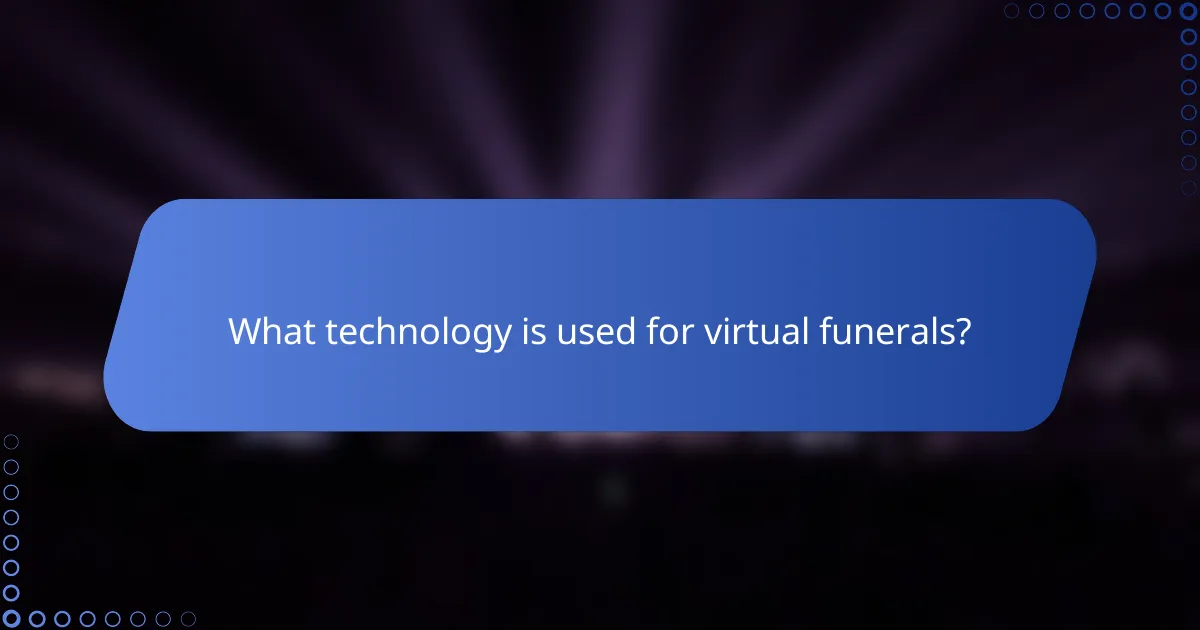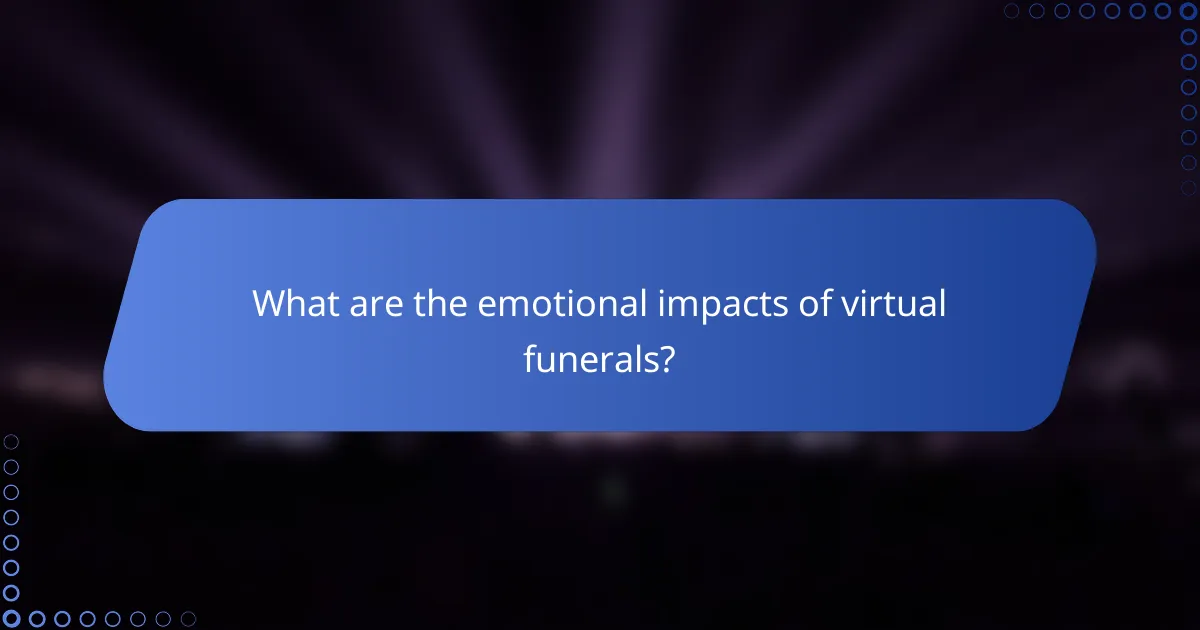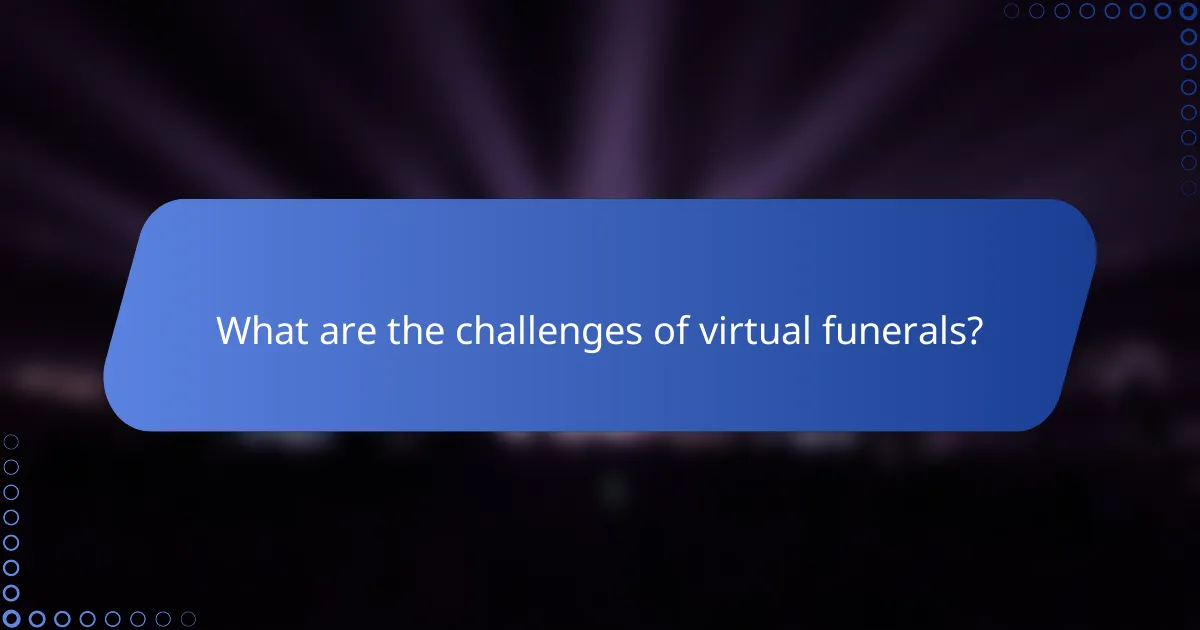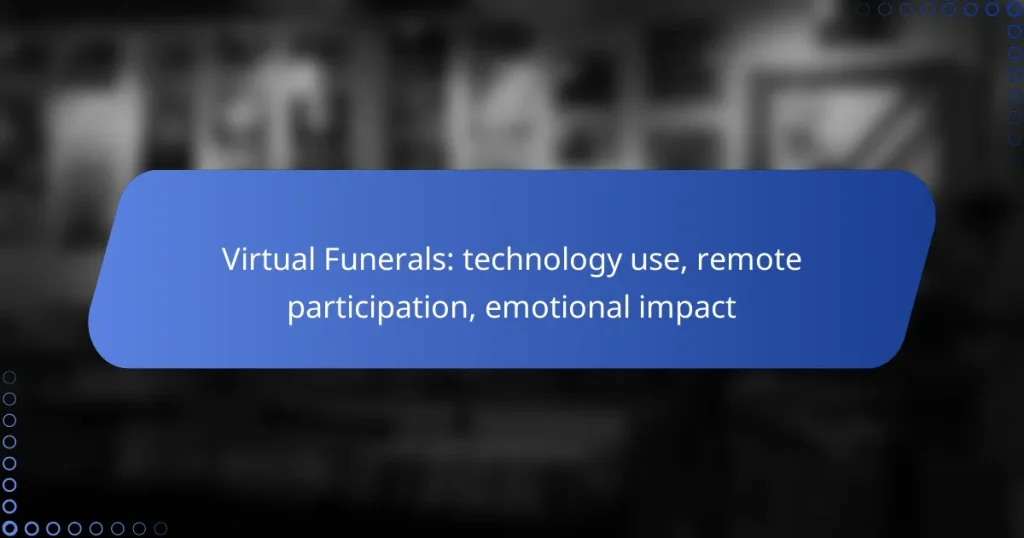Virtual funerals have emerged as a significant way for families and friends to honor their loved ones while participating remotely, utilizing various technologies to bridge distances. These services often involve live streaming, allowing attendees to share their memories and condolences from anywhere, thereby transforming traditional mourning practices. While they offer connection and support, virtual funerals can also evoke complex emotional responses, influencing how individuals experience and process their grief.

How do virtual funerals work in Canada?
Virtual funerals in Canada allow families and friends to participate in memorial services remotely, using various technologies to connect with one another. These services typically involve live streaming the event, enabling attendees to share their condolences and memories from anywhere in the country.
Live streaming platforms
Live streaming platforms are essential for hosting virtual funerals, as they provide a way for participants to view the service in real-time. Common platforms used include Zoom, Facebook Live, and YouTube, each offering different features such as chat functions and screen sharing. When choosing a platform, consider factors like ease of use, accessibility for attendees, and privacy settings.
For a seamless experience, ensure that the chosen platform can accommodate the expected number of participants, which can range from a handful to hundreds. Testing the technology beforehand can help avoid technical issues during the service.
Virtual memorial services
Virtual memorial services can be tailored to reflect the deceased’s personality and preferences, often incorporating multimedia elements such as photo slideshows or video tributes. These services can be held live or recorded for later viewing, allowing flexibility for those unable to attend at the scheduled time.
In Canada, families may also choose to include a virtual guestbook where attendees can leave messages or share memories. This interactive element can enhance the emotional connection among participants, even from a distance.
Remote participation tools
Remote participation tools enhance the virtual funeral experience by allowing attendees to engage actively. Features like chat rooms, Q&A sessions, and polls can facilitate interaction and provide a sense of community. Some platforms even offer breakout rooms for smaller group discussions after the main service.
When planning for remote participation, consider the technological literacy of your audience. Providing clear instructions on how to join and participate can help ensure that everyone feels included and comfortable during the service.

What technology is used for virtual funerals?
Virtual funerals utilize various technologies to facilitate remote participation, allowing mourners to connect and pay their respects from anywhere. Key technologies include video conferencing software, virtual reality applications, and social media integrations, each serving unique purposes in enhancing the experience.
Video conferencing software
Video conferencing software is the backbone of most virtual funerals, enabling real-time interaction among participants. Popular platforms like Zoom, Microsoft Teams, and Google Meet allow families to host services that can accommodate dozens to hundreds of attendees, depending on the plan chosen.
When selecting a platform, consider features such as screen sharing, recording options, and ease of use for attendees who may not be tech-savvy. It’s advisable to conduct a test run before the actual service to troubleshoot any potential issues.
Virtual reality applications
Virtual reality (VR) applications offer an immersive experience for virtual funerals, allowing participants to feel as though they are physically present. Platforms like AltspaceVR and VRChat can create virtual environments where attendees can gather and interact in a 3D space.
While VR can enhance emotional connections, it requires participants to have VR headsets, which may limit accessibility. It’s essential to weigh the benefits of immersion against the need for broader participation, ensuring that those without VR equipment can still join the service.
Social media integrations
Social media integrations play a vital role in promoting virtual funerals and allowing for broader community engagement. Platforms like Facebook and Instagram can be used to share live streams or recorded services, making it easy for friends and family to participate from afar.
When using social media, ensure privacy settings are appropriately configured to protect the family’s wishes. Consider creating a dedicated event page or group where attendees can share memories and condolences, fostering a sense of community during the grieving process.

What are the emotional impacts of virtual funerals?
Virtual funerals can evoke a range of emotional responses, from comfort to isolation. While they provide a platform for remote participation, they may also alter traditional mourning practices and affect how individuals process grief.
Connection with distant attendees
Virtual funerals enable family and friends who are far away to participate in the memorial service, fostering a sense of connection despite physical distance. This can be particularly beneficial for those who may not have been able to travel due to financial constraints or health issues.
By using video conferencing tools, attendees can share memories and support one another in real-time, creating a communal experience that might not be possible otherwise. This accessibility can strengthen bonds and provide comfort during a difficult time.
Grieving process support
Participating in a virtual funeral can offer essential support for the grieving process. Attendees can express their condolences, share stories, and engage in rituals that honor the deceased, which can aid in emotional healing.
Many platforms allow for interactive features, such as chat functions or virtual guest books, where attendees can leave messages of support. This can help individuals feel less isolated in their grief and encourage ongoing conversations about loss.
Challenges of remote mourning
Despite the benefits, virtual funerals come with challenges that can impact the mourning experience. The lack of physical presence may lead to feelings of disconnection or inadequacy in expressing emotions, as non-verbal cues are often lost in digital formats.
Additionally, technical issues such as poor internet connectivity can disrupt the service, adding frustration to an already emotional event. It is crucial for organizers to prepare thoroughly, ensuring that all participants have the necessary information and support to navigate the online platform effectively.

How do families choose virtual funeral services?
Families typically choose virtual funeral services based on their specific needs, preferences, and the technology available. Key factors include the service provider’s reputation, cost, and customization options that align with their vision for the memorial.
Service provider comparisons
When selecting a virtual funeral service, families should compare different providers based on features, user experience, and customer reviews. Some popular platforms offer live streaming, video recording, and interactive elements like chat rooms, while others may focus on simplicity and ease of access.
It’s beneficial to look for providers that have experience with virtual services, as they can offer valuable insights and support. Families can create a shortlist by checking online reviews and asking for recommendations from friends or funeral directors.
Cost considerations
The cost of virtual funeral services can vary widely, typically ranging from a few hundred to a couple of thousand dollars. Factors influencing the price include the technology used, the length of the service, and any additional features like video editing or memorial websites.
Families should also consider any hidden fees, such as those for technical support or extra services. Comparing packages from different providers can help identify the best value for the desired features.
Customization options
Customization is a key aspect of virtual funerals, allowing families to create a personalized experience that reflects the deceased’s life. Options may include custom themes, music playlists, and video tributes that can be integrated into the service.
Families should inquire about the level of customization each provider offers and whether they can incorporate personal elements like photos or stories. This can enhance the emotional impact of the service and provide a meaningful way to honor the loved one.

What are the benefits of virtual funerals?
Virtual funerals offer several advantages, including increased accessibility for attendees, cost savings, and flexible scheduling options. These benefits make it easier for families to honor their loved ones while accommodating various circumstances.
Accessibility for remote guests
Virtual funerals allow friends and family members who cannot travel to participate in the ceremony from anywhere in the world. This is particularly beneficial for those living far away or with mobility issues, ensuring that everyone can share their condolences and memories.
To enhance accessibility, families can use platforms that support live streaming and video conferencing. Providing clear instructions on how to join the service can help ensure that all guests can participate without technical difficulties.
Cost-effectiveness
Hosting a virtual funeral can significantly reduce costs associated with traditional services, such as venue rentals, catering, and printed materials. Families can save money while still providing a meaningful experience for attendees.
For example, the average cost of a traditional funeral can range from several thousand to over ten thousand USD, while virtual options may only require a modest investment in technology and online services. This financial relief can be crucial during a challenging time.
Flexible scheduling
Virtual funerals offer greater flexibility in scheduling, allowing families to choose a time that works for the majority of participants. This can be especially helpful when coordinating across different time zones or accommodating various schedules.
Families can consider hosting the service on a weekend or during the evening to maximize attendance. Additionally, many platforms allow for recordings of the service, enabling those who cannot attend live to watch later at their convenience.

What are the challenges of virtual funerals?
Virtual funerals present several challenges that can impact the experience for attendees and families. Key issues include technical difficulties, the absence of physical presence, and privacy concerns, all of which can affect how mourners connect and grieve.
Technical difficulties
Technical difficulties can disrupt virtual funerals, making it hard for participants to engage fully. Common issues include poor internet connections, software glitches, and inadequate audio-visual equipment.
To mitigate these problems, families should conduct a test run before the event. Ensuring all participants are familiar with the platform can help reduce the likelihood of disruptions during the actual service.
Lack of physical presence
The lack of physical presence in virtual funerals can hinder emotional support among attendees. Many people find comfort in being physically close to others during times of grief, which is not possible in a virtual setting.
To address this, families can encourage attendees to share memories or messages in real-time through chat features or video calls. This can help foster a sense of community despite the physical distance.
Privacy concerns
Privacy concerns are significant in virtual funerals, especially regarding the sharing of personal information and the potential for uninvited guests to join the service. Families must consider who has access to the event and how to secure it.
Using password protection or invitation-only links can help maintain privacy. Additionally, families should inform attendees about the platform’s privacy settings to ensure everyone feels secure during the service.


